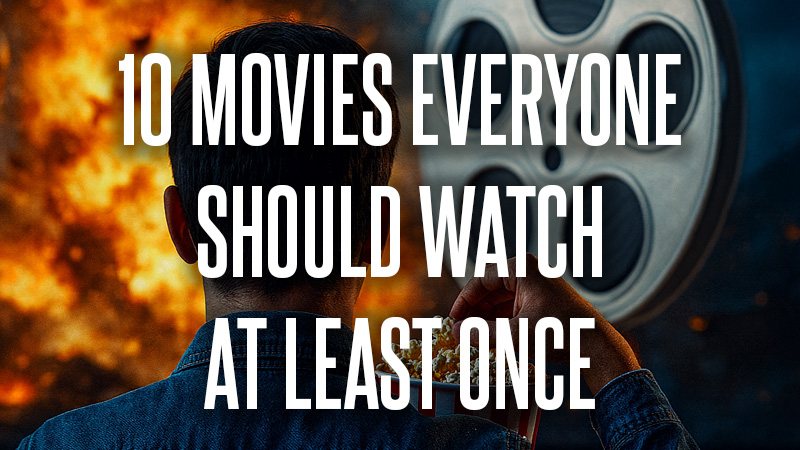10 Movies Everyone Should Watch At Least Once
There are films that entertain us, films that challenge us, and films that stay with us long after the credits roll. Some are masterclasses in craft, others are cultural milestones, and a few manage to be both. Whether they broke new ground, captured a moment in history, or simply told timeless human stories, these movies have earned their place in the collective consciousness.
Here are 10 films that everyone should experience at least once. They’re not just classics. They’re cinematic landmarks that remind us why movies matter.
Casablanca (1942)
Few films embody the magic of classic Hollywood like Casablanca. Released during World War II, this romantic drama set in Vichy-controlled Morocco became a cultural touchstone almost overnight. Starring Humphrey Bogart and Ingrid Bergman, the film follows Rick Blaine, a cynical nightclub owner whose past catches up with him when his former lover walks through his door with her resistance leader husband.
What makes Casablanca timeless is not just its iconic dialogue or memorable scenes, but the emotional weight beneath them. “Here’s looking at you, kid” and “We’ll always have Paris” have become part of cinematic language, but they resonate because they emerge from a story about sacrifice, moral choices, and the complexities of love in a world on fire. Director Michael Curtiz and the screenwriters crafted a film that blends romance, political intrigue, and heartbreak with perfect balance. More than 80 years later, it remains a masterclass in storytelling and emotional precision.
Citizen Kane (1941)
No list of essential films is complete without Citizen Kane. Orson Welles’ debut remains one of the most analyzed and discussed films in history, and for good reason. Welles, just 25 at the time, wrote, directed, produced, and starred in this groundbreaking portrait of media tycoon Charles Foster Kane.
From its innovative deep-focus cinematography to its non-linear narrative structure, Citizen Kane redefined what cinema could do. It’s both a mystery and a character study, unraveling Kane’s life through the memories of those who knew him best. The film’s famous final revelation, “Rosebud,” has entered pop culture lore, but the journey there is what makes it remarkable. Welles and cinematographer Gregg Toland pushed the boundaries of visual storytelling, creating shots that are still studied by filmmakers today.
Beyond its technical brilliance, Citizen Kane is a meditation on ambition, loneliness, and the cost of power. It’s a film that rewards multiple viewings, revealing new layers each time. Whether you’re a casual moviegoer or a cinephile, watching Citizen Kane is like walking through the blueprint of modern cinema.
Schindler’s List (1993)
Steven Spielberg’s Schindler’s List is one of the most devastating and essential films ever made. Based on the true story of Oskar Schindler, a German industrialist who saved more than a thousand Jews during the Holocaust, the film is both a historical document and a profoundly human story.
Shot mostly in black and white, Spielberg and cinematographer Janusz Kamiński create a stark, unflinching depiction of one of history’s darkest chapters. Liam Neeson delivers a career-defining performance as Schindler, charting his transformation from opportunistic businessman to reluctant hero. Ralph Fiennes is chilling as Amon Göth, embodying the banality and brutality of evil.
What sets Schindler’s List apart is its refusal to sensationalize. It shows the horrors of the Holocaust with clarity and respect, allowing moments of humanity to shine through the darkness. The red coat sequence remains one of the most powerful uses of color in film history. This is not a film one “enjoys,” but it’s a film that everyone should see. It’s a reminder of what cinema can do when it bears witness to history.
The Shawshank Redemption (1994)
Frank Darabont’s The Shawshank Redemption has achieved something rare. It’s a film that grows in stature with each passing year, finding new audiences and deeper appreciation long after its release. Based on Stephen King’s novella Rita Hayworth and Shawshank Redemption, the film tells the story of Andy Dufresne (Tim Robbins), a banker wrongly convicted of murder, and his decades-long friendship with fellow inmate Ellis “Red” Redding (Morgan Freeman).
At its heart, Shawshank is a story about hope. Darabont’s direction is restrained but precise, allowing the emotional power of the story to build naturally. Freeman’s narration lends the film a timeless, almost mythic quality, while Robbins delivers a performance filled with quiet strength. Thomas Newman’s haunting score amplifies the film’s themes of perseverance and redemption.
Though it was initially overshadowed at the box office, The Shawshank Redemption has become one of the most beloved films of all time. Its message is universal: even in the darkest places, hope can endure.
The Godfather (1972)
Francis Ford Coppola’s The Godfather is a cornerstone of American cinema. Adapted from Mario Puzo’s novel, the film tells the story of the Corleone crime family with operatic grandeur and intimate detail. Marlon Brando’s portrayal of Vito Corleone is legendary, but Al Pacino’s transformation from reluctant outsider to ruthless leader is the film’s beating heart.
What makes The Godfather essential is its meticulous craftsmanship. Coppola’s direction, Gordon Willis’s moody cinematography, and Nino Rota’s haunting score combine to create an immersive world that feels both mythic and real. The film examines power, loyalty, family, and corruption with a depth that transcends the gangster genre.
It’s also endlessly quotable, from “I’m gonna make him an offer he can’t refuse” to “Leave the gun, take the cannoli.” Watching The Godfather is to witness a film that changed Hollywood, influencing everything that followed.
Psycho (1960)
Alfred Hitchcock’s Psycho remains one of the most shocking and influential thrillers ever made. At a time when Hollywood was bound by strict content codes, Hitchcock shattered expectations with a film that broke rules and terrified audiences. The infamous shower scene alone changed the language of horror and suspense, but Psycho is more than its most famous moment.
Anthony Perkins gives a haunting performance as Norman Bates, one that remains iconic more than six decades later. Janet Leigh’s early exit from the film stunned viewers and paved the way for modern thrillers to subvert audience expectations. Bernard Herrmann’s score, with its piercing strings, is still instantly recognizable.
Psycho redefined what a thriller could be, blending psychological horror with masterful storytelling. It’s the kind of film that continues to influence filmmakers today, from slasher movies to prestige dramas.
Star Wars (1977)
Few films have reshaped popular culture like George Lucas’s Star Wars. When it debuted in 1977, it was unlike anything audiences had ever seen. Drawing from myth, westerns, samurai films, and serial adventures, Lucas crafted a space opera that felt both familiar and completely new.
The story of Luke Skywalker’s journey from farm boy to hero is timeless, and the world Lucas built remains one of cinema’s most enduring creations. John Williams’ score became an instant classic, and the special effects set new standards for what movies could achieve.
But beyond the spectacle, Star Wars tapped into something elemental. It offered hope, adventure, and a clear moral universe at a time when audiences craved escapism. Whether you’re watching it for the first time or the hundredth, Star Wars retains its power to transport.
Pulp Fiction (1994)
Quentin Tarantino’s Pulp Fiction didn’t just entertain. It changed the cinematic landscape of the 1990s. Its nonlinear structure, stylized dialogue, and bold blend of humor and violence marked a turning point in independent film. Tarantino took the familiar language of pulp crime stories and filtered it through his unique sensibility, creating something entirely new.
John Travolta’s comeback, Samuel L. Jackson’s career-defining performance, Uma Thurman’s enigmatic presence, and Bruce Willis’s gritty arc all intersect in ways that are both surprising and satisfying. Every scene crackles with energy, and the soundtrack became as iconic as the film itself.
Pulp Fiction is a reminder of how fresh and alive movies can feel when they break the rules with purpose. It’s endlessly quotable, stylish, and influential.
Spirited Away (2001)
Hayao Miyazaki’s Spirited Away is a masterpiece of animation and storytelling. The film follows a young girl named Chihiro who stumbles into a mysterious spirit world after her parents are transformed into pigs. What follows is a journey of courage, identity, and wonder.
Miyazaki’s world is breathtakingly imaginative, filled with unforgettable characters and surreal imagery. Yet beneath the fantasy lies a deeply human story about growing up and facing fears. The hand-drawn animation is stunning, and Joe Hisaishi’s score elevates the emotional resonance.
Spirited Away became the first (and so far only) hand-drawn, non-English-language film to win the Oscar for Best Animated Feature. It’s a timeless reminder of the power of animation to tell stories that resonate across cultures and generations.
Interstellar (2014)
Christopher Nolan’s Interstellar is an ambitious blend of science fiction spectacle and deeply emotional storytelling. Set in a near-future where Earth is becoming uninhabitable, the film follows a group of astronauts on a mission to find a new home for humanity. Matthew McConaughey delivers one of his best performances as Cooper, a father forced to leave his daughter behind in the hope of saving her future.
Nolan combines theoretical physics with human drama, exploring time, gravity, and love on a cosmic scale. Hans Zimmer’s soaring score gives the film an almost spiritual dimension, and Hoyte van Hoytema’s cinematography makes space feel both beautiful and terrifying.
Interstellar is a modern epic, one that rewards repeat viewings with its emotional and intellectual depth. It’s a reminder that cinema can still inspire awe and wonder.




